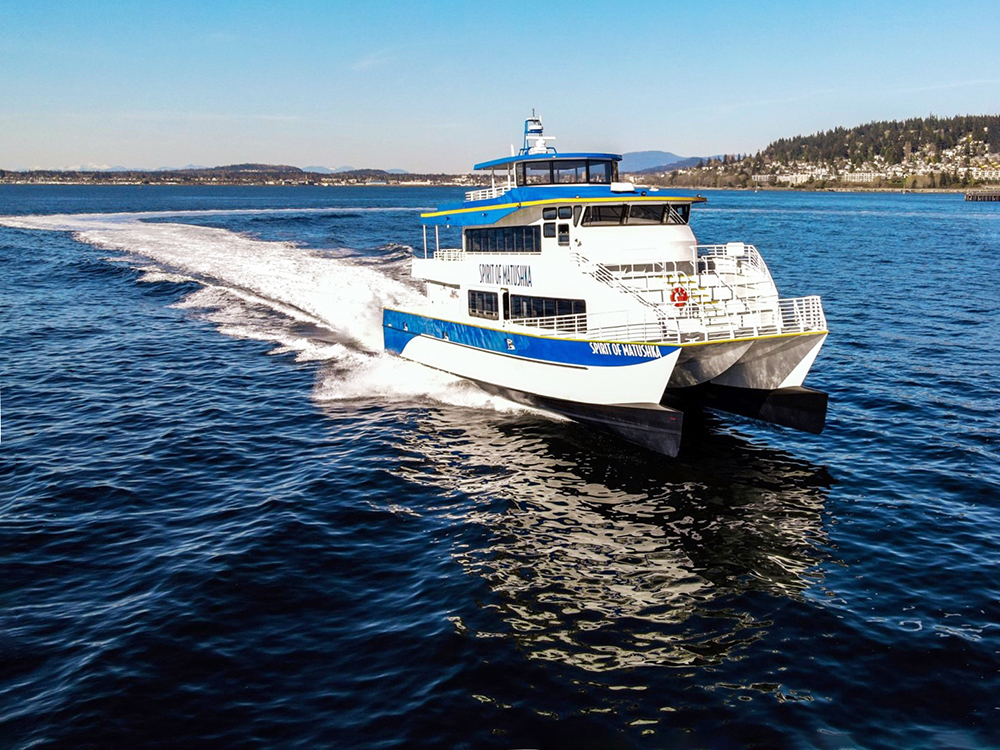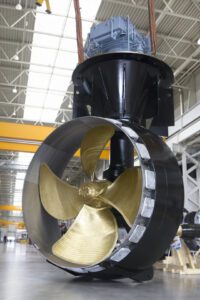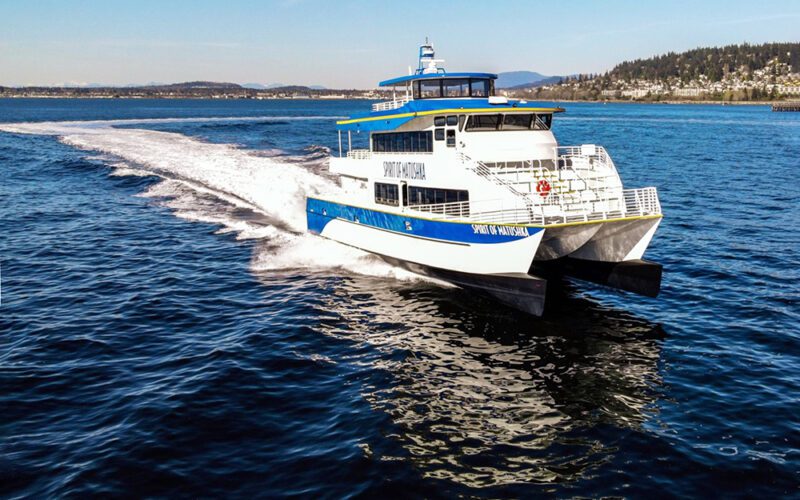
Veteran propulsion technology merges with new innovations.
The propulsion technology space is a dynamic and important one for maritime professionals. Technologies with generations of proven success merge and clash with cutting-edge new inventions in a globe-spanning market with players jockeying for position.
New opportunities like the wind-farm industry spring up alongside more traditional operations such as oil-spill response vessels and Alaskan tourism. Here are a few things on our radar.
Scania
Scania USA, a subsidiary of Scania CV AB of Sweden, is an importer for industrial and marine engines in North America and a provider of transportation solutions both on land and sea with 50,000 employees across 100 countries.
The company’s marine division has provided propulsion systems on everything from patrol and fishing boats to passenger ferries and cargo ships. Scania’s marine engines span from 220 to 1,150 horsepower (162 to 846 kW) plus instrumentation, after-treatment systems and other adjacent powertrain components.
Scania’s recent accomplishments include being selected by Marine Spill Response Corp. to power its new fleet of five 47-foot Skimmer oil-response vessels. The vessels, expected to be delivered in 2024, are being built by Mount Vernon, Wash.-based Rozema Boat Works and are to be powered by twin DI13 087M 700-horsepower engines provided by Cascade Engine Center of Tukwila, Wash.
Scania was also selected by Patriot Offshore Maritime Services to power a new 88-foot (27-meter) aluminum crew-transfer vessel. The vessel is chartered by Vineyard Wind to support the construction and management of its commercial offshore wind project, an 800-megawatt wind farm 15 miles off the coast of Martha’s Vineyard.
Major Marine Tours of Seward, Alaska also chose Scania to power its latest generation whale watching vessels. The 87-foot Spirit of Matushka, delivered in the spring of 2021 and its sister ship Skana, were built by Bellingham, Wash.-based All American Marine.
The vessels are powered by four DI16 082M 800-horsepower engines supplied by Cascade Engine Center and propelled by Hamilton 422 WaterJets. The custom-built catamarans are capable of a top speed of 32 knots with a full capacity of 150 passengers and full fuel; with a lighter load they can reach 36 knots, making them the fastest, most fuel-efficient vessels in the Major Marine Tours fleet.

Schottel
Schottel is a manufacturer of propulsion and steering systems for ships and offshore application with roots dating to 1921 in an old barn near Koblenz, Germany. Company founder Josef Becker is credited with the invention of the rudder propellor, or z-drive, in 1950.
The company, headquartered in Spay, Germany, now has a global reach with 15 subsidiaries. According to Schottel, it offers a large range of propulsion and control systems with power ranges from 50 to 30,000 kilowatts, from azimuth propulsion systems or controllable pitch propellers, main propulsion units or maneuvering aids, rudder propellers or automation systems.
Among Schottel’s notable recent achievements is powering the world’s first hydrogen-powered tugboat, built in the Spanish shipyard Astilleros Armon, for a working life at the Port of Antwerp-Bruges in Belgium, Europe’s second largest seaport in Europe after Rotterdam.
The tug’s main propulsion system is two Schottel RudderPropellers, type SRP 460 (2,000 kW each) with propeller diameters of 7.87 feet (2.4 meters). The 101-foot by 41-foot vessel should achieve bollard pull of 65 tons.
According to Schottel, the SRP units are driven by combustible engines that burn hydrogen in combination with diesel. Combustion of hydrogen does not emit any CO2, and the particle filter combined with the catalyzer results in minimal emissions of NOx and particulates.
The company also announced a Schottel TransverseThruster with new elastic well installation for less noise. The TransverseThruster, when paired with the elastically mounted well installation, reduces sound emissions by up to 11 decibels, according to the company.
The sound optimized STT should also minimize underwater noise. The low-vibration design is for vessels of all types and sizes, especially for service-operation vessels that need to excel in maximum comfort and high-dynamic positioning accuracy.
Schottel is also a major player in offshore wind projects, including recently delivered service operation vessels like the Wind of Hope and the Bibby WaveMaster Horizon. The company claimed over 600 offshore vessels have been equipped with the German propulsion systems. Schottel recently announced a new rudder propeller optimized for dynamic positioning.
“With the SRP-D, we have significantly increased the DP performance of our rudder propellers, resulting in a product that meets the requirements of today’s offshore wind industry even better,” Schottel Technology Vice President Manfred Heer said in a statement. “For customers, this means a significant increase in safety and possible operating times on offshore structures, especially in difficult weather conditions.”
Greenbrier Marine
While not strictly a propulsion systems provider, Greenbrier Marine is a Portland, Ore.-based manufacturer of ocean-going barges with more than 100 years of experience and reportedly over 2,000 barges launched.
The company customizes barge builds specific to the unique needs of the maritime industry and boasts the longest side-launch capability on the West Coast. Its deep-water facility is equipped with high-definition plasma burning tables, CNC-controlled profile-cutting machine, two 200-ton whirley cranes and a 1,200-foot outfitting dock.
Matson’s new flat-deck container barge, Haleakala, was launched at the Greenbrier Gunderson Marine shipyard in April 2022. The new barge is deployed for Matson’s Neighbor Island service in Hawaii to connect cargo to and from the U.S. West Coast through its hub terminal in Honolulu.
With a carrying capacity of 620 TEU and room for 72 refrigerated containers, the new Haleakala is double the size of the older barge it replaced. The Haleakala is Matson’s largest barge at 362 feet long, 105 feet wide (beam), with a deep draft of 17.3 feet and capacity of more than 12,000 metric tons.
A new barge is also being built to help capture and treat stack exhaust from vessels in the ports of Los Angeles and Long Beach. Produced and operated by Clean Air Engineering-Maritime, Inc. (CAE-M), the barge will carry a vessel stack exhaust capture and treatment system called the Marine Exhaust Treatment System (METS-3), designed by Fassmer Technical Projects to remove diesel emissions from the auxiliary engines and boilers of ocean-going vessels while at berth or anchor.
The 26-meter-long (85.3 feet) and 13-meter-wide (42.6 feet) barge is being built by Greenbrier. The barge’s main propulsion system consists of two electrically driven Schottel RudderPropellers type SRP 150 (400 kW each) with 3.9-foot (1.2 meter) propellers. The SRPs are said to run on biodegradable oils.
Norris Comer is a Seattle-based writer and author. His debut memoir, Salmon in the Seine: Alaskan Memories of Life, Death, & Everything In-Between is now available wherever books are sold. You can find him on Substack, Instagram and at norriscomer.com. He can be reached via email at norriscomer@substack.com.

